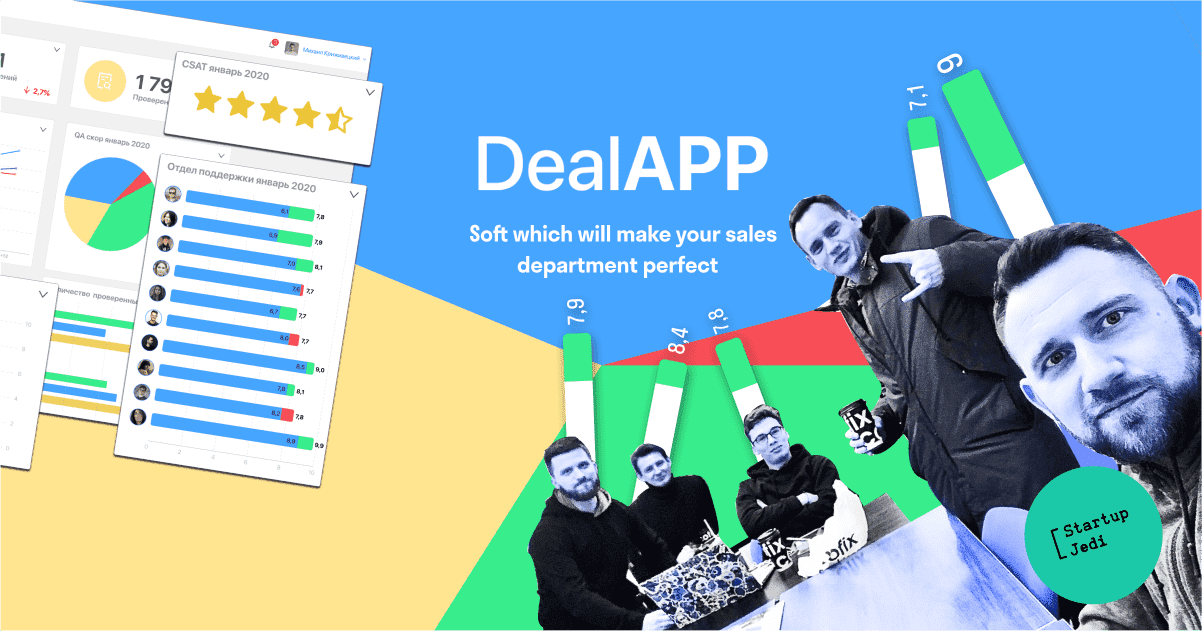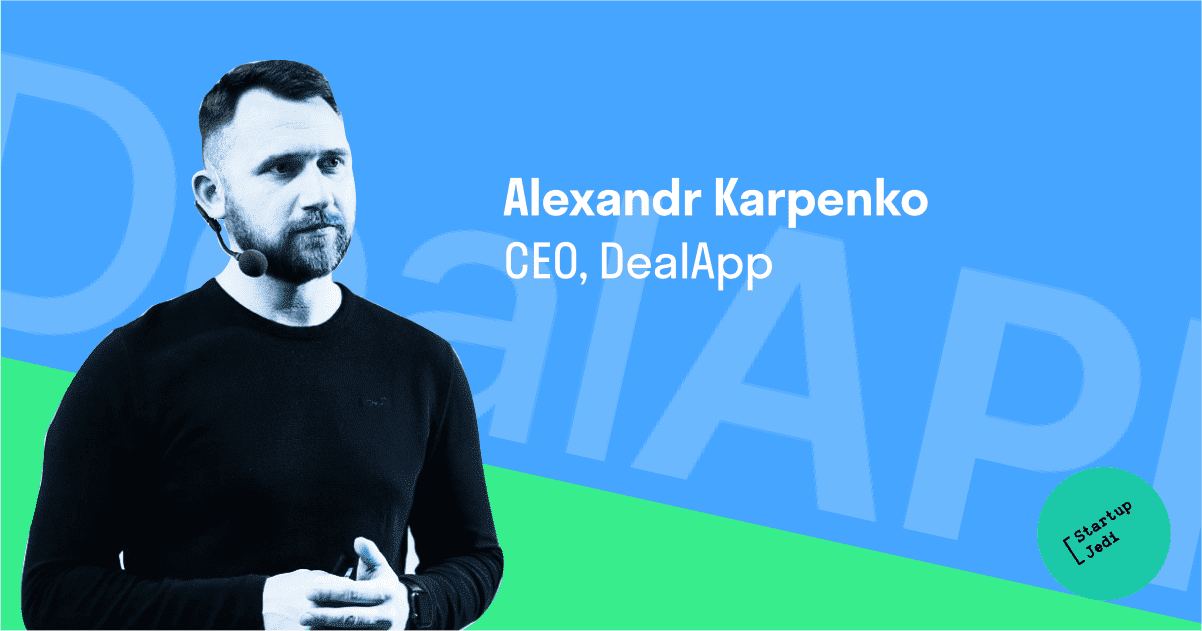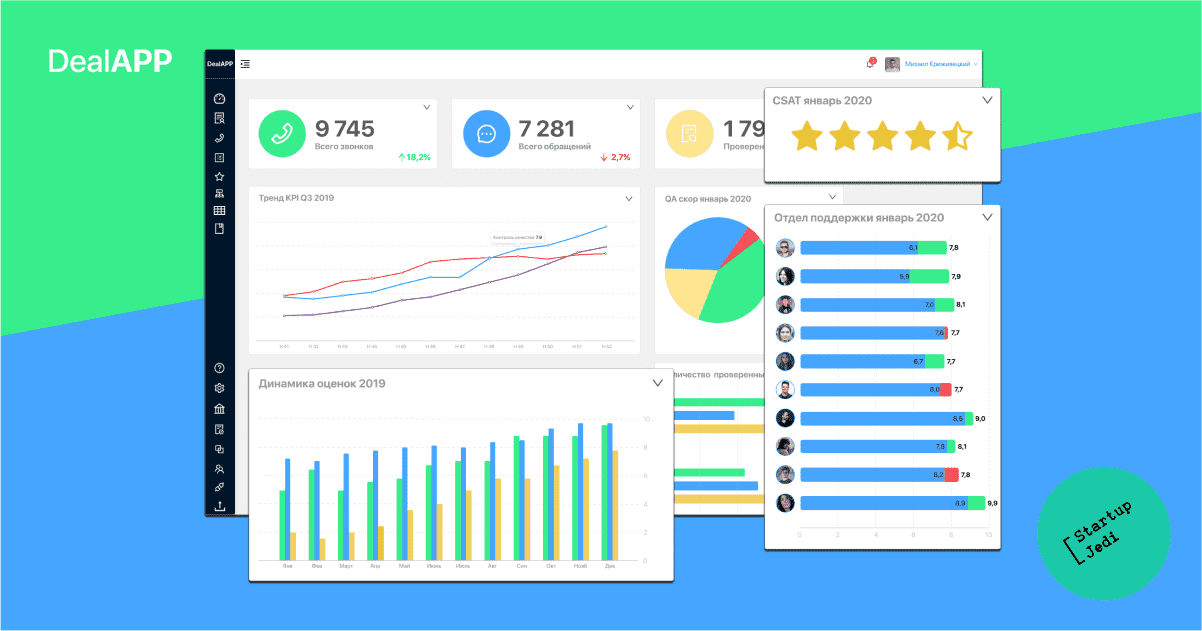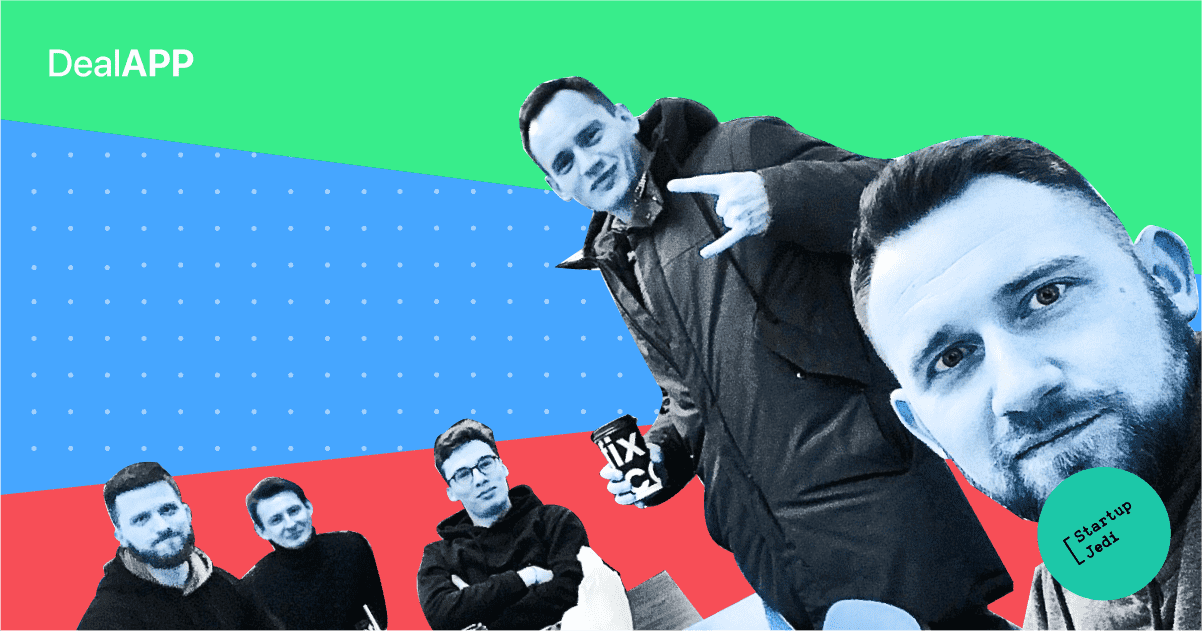
Startup Jedi
We talk to startups and investors, you get the value.
It is hard to build an effective workflow without achieving KPI. However, quite often effectiveness isn’t measured in figures only. How to track the responsiveness of your managers to the clients’ needs? How to understand whether managers care about clients, not just providing product or service, so that they would be satisfied? The team of the Belarusian DealApp startup has found a solution to this problem. Alexander Karpenko, one of the founders, told us how they created the startup.

Startup Jedi
We talk to startups and investors, you get the value.
DealApp is an application for monitoring and evaluating work quality of sales managers, which can be built-in in a company’s CRM or VoIP (VoIP, Voice over Internet Protocol, IP-telephony — a technology that allows calling via Internet; it underpins almost all messenger applications, where calls are available).
Thanks to the extensive functionality, the software helps to find points of growth for developing employee’s communicative skills, track situations, which need operative measures, create reports, evaluate calls and teach the personnel.
...
- What was a kick-off for you to start?
- In the past, together with another partner — Andrey Karpenko, we were interacting and training sales departments.
All sales departments face quite similar problems. In the beginning, we always were listening to 20–30 calls for better understanding of the client’s problem. As everyone (before us), we have used Excel or Google Sheets, which was extremely inconvenient. At some point, we understood that we weren’t alone with facing this problem.
Our first decision was to fully automate the process by using Speech-To-Text technology. We started working on a project, where the company downloads all their calls in a system and then the system identifies which calls were successful and which were of bad quality. It is a dream of every sales department manager. However, it appeared that in real-time conditions, there are specific pitfalls in this direction.
In one moment, Andrey and I had to make a difficult decision not to continue working in this direction. But while working on the project, we gained a lot of useful contacts and assets in call centres and a lot more in sales departments. We understood that the problem still exists. So we started over, we met our clients once again and started to touch up the outlines of how the quality assurance process works in these companies.
Our product is based on feedback from our current clients and those with whom we have negotiated before. We just made an application that solves their business problems.
In a few weeks, we had enough data to create a prototype. We’ve created interface mock-ups of our application in Figma and went up for sale. At our very first meeting, we got it very clear — the client is ready to buy such kind of software. After that, we had many meetings, where potential clients expressed willingness to buy our software. We started looking for a team of developers.

- How does the project work: a step-by-step guide
- The company connects our software to their CRM or VoIP, while we synchronize the data.
After that, QA personnel or managers choose those calls or chats, which should be evaluated. And after that, they appear in the evaluative interface. This is our favourite moment.
Before this, they had to use at least 2–3 tools for evaluation. The employee opened a media player for listening to a call, in another tab he opened sheets with a check-list and a tab with a CRM card. At this very moment, they spent 30–40% of their time switching between the tabs and copying the information from one app into another. In our application, all tools are gathered on one page and the user interacts with it. Lastly, the results of these evaluations are automatically transformed into reports and infographics.
- What is your unique offer for your clients who got used to working with Google Sheets — what assures them to use the DealApp platform?
- I guess, we just hit the right nail for the majority of the company, which has the quality assurance process. Once, we had this pain too, and it appeared that 95% of companies have this problem. We didn’t mastermind anything, we just listened to what difficulties encountered QA personnel and managers, and transformed this knowledge into business-logics and interfaces. Long story short, we talk the same language with our clients.
...

- How long have you been working on your startup?
- Since September 2019, when the idea of a project hit us.
- At what development stage is your project now?
- In May, we finished the beta-version and presented the application with its full functionality. With this, while we were developing the product — we were selling it at the same time. For example, the first sale (pre-order) was after a presentation, when we didn’t even have the first beta-version. During that time, we understood who our target clients are, how to find them and how to integrate. As for now, our main aim is to scale sales by using different channels.
- What does your perfect product look like?
- I’m sure that we have many different inventions and changes. Still, we know about those features, which will definitely become useful to our clients. The Roadmap is written for the next 18 months, but we constantly prioritise something there and make changes. So far, we are planning to collaborate with Zendesk, Pipedrive, SalesForce and Intercom.
...

- What business model underpins the basis of the project?
- We are pure SaaS. We use a subscription model; in other words, we receive payment for every user in the system. The monthly user price is $6.
- You have quite a comprehensive starter pack. Is it possible that some of your clients won’t pay you at all?
- We have more paying clients than free of charge clients. The basic pack is more for demonstration of the app functionality rather than for process development. Still, it is enough for small teams of 3–5 people.
- Has the project reached self-sufficiency?
- We are on the verge of it. I think it’s going to happen in the next month.
- How did you develop the project? Have you attracted any investors?
- We invested a lot of money in the project. However, I consider the greatest investments the fact that 3 founders have been working together full time on a project for 6 months. Besides, we have gone through the TechMinsk acceleration program and raised financing from them.
- How much more money do you need to invest in the project?
- This year, we need to invest from $200 000 to $400 000 more. Considering future prospects, we have an example of a company that develops quite a similar product, and last year, they raised a round of $1.9 million.
...

- Who are your clients?
- Those are call-centres and sales teams of 20 to 200 employees that use CRM and VoIP-systems and have QA-personnel. With this, we are working with companies who have 500+ employees.
- How do you promote your product?
- We sell, sell and sell again:) We started to create content and in the result, we have leads from this direction.
- How do you reach your clients?
- Still, LinkedIn is our main channel, but most applications we receive from the website. Plus, now, we’ve significantly narrowed our focus on a specific category of clients, who we reach directly through the cold calls.
At the first stage, we also used LinkedIn as a method for testing hypotheses. We contacted many large companies, large call-centres, with 400–500 employees — we didn’t have any specific focus.
In time, with LinkedIn, we managed to define that our main goal is companies with 20–200 employees. It’s easier for us to close them — we manage to satisfy their needs faster. By LinkedIn, we do not stop working, although we have shifted the focus a bit. Moreover, as for now, we already know exactly where to look for companies with personnel of 20–200 employees. Accordingly, it’s more efficient for us to call them directly than to write them on LinkedIn.
- Have you already gotten feedback from clients?
- Of course. It is one of the fundamental things in our work. We support clients on their way of working with our application. We have a lot of feedback. For example, one of our clients found quite a serious problem in his sales department after using the application for three weeks, which he hadn’t noticed for 2 years. Unfortunately, we can’t disclose the problem itself, these are the NDA terms and conditions. In general, we often hear that “if we were doing such a kind of software by ourselves, we would do the same thing as you did”. We paid maximum attention to the QA process and we continue working in this direction.
...

- Correct me if I’m wrong: as for now, you are working on Belarusian and Russian markets and then you are planning to scale
- As for now, we have users in Belarus, Russia, Kazakhstan, Ukraine and Georgia. We also have requests for the English version of a product. We are working in this direction.
- Who are your competitors?
- This is my favourite question. When we found our first competitors from England and the USA, it was one of the best days on working on the project. On the international market, there are 8 companies that solve the same problem and use quite the same method. Again, Excel and Google Sheets.
Each of our competitors have their specificities and focus. We precisely scrutinize and analyse the actions of each of them. We have a huge document with detailed analysis and review to each of them. And, of course, we have used each of them.
If we’re talking about the advantages of our product, then as for now, it is obviously the analytical part. Clients adore our dashboard and its functionality.
In addition, we focus more on the sales departments rather than on supporting teams.
- What are the project goals for the next year?
- At this stage, we are focused on one single metric — the growth of consolidated revenue — from $10 000 a month, plus % adding another 20–30% monthly.
...

- Who’s in the team and without whom this project simply wouldn’t exist?
- I am deeply concerned that every successful product is a result of teamwork. At this point, I can’t say without whom our product wouldn’t exist. Each of us adds his or her contribution. Somebody brings the new clients, it’s vital. Somebody deals with onboarding clients, which is also important. And some write codes and enable all previous actions.
For instance, Andrey has over 15 years of experience in sales and training. Sasha (the CTO of the project) has 12 years of experience in IT. She has also worked on many international projects. I have 10 years of experience in sales and sales management.
But honestly, I don’t want to outline us in the whole team. As I’ve mentioned before, each member of the team has contributed to the project, not only three of us. Now we have 8 members in the team.
- What specialists were the hardest to find?
- It is about people, not specialists. It is possible to find a good specialist, but an enthusiastic person, who is completely involved in the process and likes the product. Each of us works at least 6 days a week, 10–12 hours a day, 6 months already.
It is a special category of people who are ready to work a lot and think it’s alright. Of course, we won’t work like this all the time, but when it is needed, everybody has a positive attitude to it. It is the hardest to find such specialists, but when you find them, you can be sure that you’ll succeed.
Facebook: facebook.com/StartupJedi/
Telegram: t.me/Startup_Jedi
Twitter: twitter.com/startup_jedi
Comments